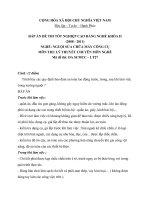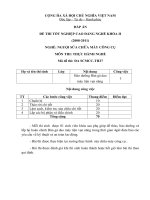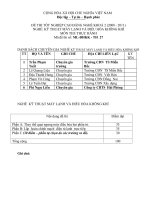Lecture Connections 27 | Protein Metabolism
Bạn đang xem bản rút gọn của tài liệu. Xem và tải ngay bản đầy đủ của tài liệu tại đây (4.03 MB, 70 trang )
Lecture Connections
27 | Protein Metabolism
© 2009 W. H. Freeman and Company
CHAPTER 27
Protein Metabolism
Key topics:
– The genetic code
– Synthesis of aminoacyl-tRNA
– Translation: RNA-dependent protein synthesis
Protein Synthesis is a
Very Complex Process
• Occurs in a large macromolecular assembly called the
ribosome, which is made of many proteins and several
RNA molecules into a functional ribosome
• Uses a large number of tRNAs that interact with mRNA
• Each tRNA is charged with one of the 20 common amino
acids by 20 different aminoacyl tRNA synthetases
• Requires a dozen or more additional protein factors for
initiation, elongation, and termination of translation
• Involves perhaps 100 additional enzymes that carry out a
variety of modifications with many proteins
Protein Synthesis Occurs on
Ribosomes
• In eukaryotes, most ribosomes are attached to the
cytosolic face of endoplasmic reticulum
Cricks’ Adaptor Hypothesis
• It was recognized in early 1950s that protein sequence is
encoded by the nucleotide sequence
• The molecular nature of players in protein synthesis
remained unknown
• Crick proposed around 1954 the adaptor hypothesis
– template is RNA (maybe rRNA)
– the amino acid is carried to the template by an adaptor
– adaptors may contain nucleotides
Early History of Protein Synthesis
Research
• 1955: Paul Zamenick’s group identifies ribosome as the
site of protein synthesis
• 1956: Volkin and Astrachan find RNA that is like DNA
but do not realize the importance of this finding
• 1958: Zamenick and Hoagland find that amino acids
became attached to what is now known as tRNA
• 1960: Sydney Brenner realizes at Good Friday meeting
with Crick and Francois Jacob and that the DNA-like
RNA of Volkin and Astrachan is the messenger RNA
The Genetic Code for Proteins
Consists of Triplets of Nucleotides
• There are 20 common, genetically encoded
amino acids
• Four letter code in groups of two is insufficient
(16)
• Four letter code in groups of three is sufficient
(64)
• Living organisms use non-overlapping mRNA
code
– One mRNA region encodes for one protein
Amino Acid Codons
• Written in the 5’ 3’ direction
• Third base is less important
Most Amino Acids Have More Than
One Codon
• Only Met and Trp have a single codon
• Some codons are better than others because of
abundance of such tRNAs
Genetic Code is Nearly Universal
Molecular Recognition of Codons in
mRNA by tRNA
• The codon sequence is complementary with the
anticodon sequence
• The codon in mRNA base pairs with the
anticodon in mRNA via hydrogen bonding
• The alignment of two RNA segments is
antiparallel
Inosinate in the Anticodon in
Some tRNAs is “Wobble”
• Inosinate can hydrogen bond with three
different nucleotides (A, U, C)
• This interaction is weaker than typical Watson
Crick base pairing
Some mRNAs are Edited Before
Protein Synthesis
• Editing involves alteration, addition, or deletion
of nucleotides in mRNA
• Editing uses guide RNA that temporarily
hybridizes with the mRNA and acts as a
template for editing









